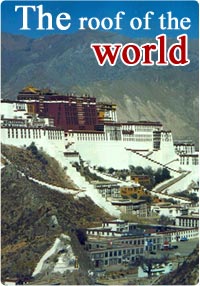 Tibet
Autonomous Region is located at the Southwest
part of China, with a land area of 1.22 million
square kilometers and a population of 2.3 million,
in which, 95% are Tibetan nationality. There are
also 30 other nationalities in Tibet, such as
Han, Menba, Luoba, Hui, Mouggul, Naxi as well
as Cheng and Sharba peoples. Tibet
Autonomous Region is located at the Southwest
part of China, with a land area of 1.22 million
square kilometers and a population of 2.3 million,
in which, 95% are Tibetan nationality. There are
also 30 other nationalities in Tibet, such as
Han, Menba, Luoba, Hui, Mouggul, Naxi as well
as Cheng and Sharba peoples. Tibet is the Qinghai-Tibetan
Plateau proper, with an average landrise of 4,000
meters above the sea level. It is well-know as
the Roof of the World and The Third Pole of the
Globe. The world highest summit- Himalayan, which
strides across the boarder between China and Nepal,
claims a height of 8,848 metres above the sea
level.
The characteristics
of the Plateau climate are the great difference
of different heights and of days and nights. The
northern part is arid and cold. On the whole,
Tibet claims a low temperature, long-day sunshine,
strong radiation, rare rainfall and thin air.
The pastoral area
of Tibet is one of the five biggest in China,
in which sheep, goat and yak are grazed. Farming
crops are mainly highland barley, wheat, bean
and rape seeds as well as some apples and walnuts.
Tibet has a forest coverage of 60,000 square kilometers,
which is the second largest timber deposit in
China. Famous and dear animal and herb medicines,
such as musk, pilose antler, bear's gallbladder,
Chinese caterpillar fungus, the tuber of elevated
gastrosits, the bulb of fritillary and the snow
lotus flower, are world-famous. The Deposit of
hydroelectric and geothermal power are at the
top of the country's reserves; solar energy is
the second.
Being the capital
city, with 1,300 years of history, Lhasa, which
means holy land of Buddha's land in Tibetan, is
the political religious economical and cultural
centre of Tibet.
Tibetan culture
originated from Tibet. Human activities traced
back to the later ages of the Paleolithic. The
king of Tibet, Songzangarbu, unified Tibet in
the 7th century. A.D and established Tibet dynasty,
which twice weaved matrimonial relations with
Tang Dynasty in the 7th and 8th centuries. In
the 13th century, Tibet became an administrative
region of Yuan Dynasty; a Gedanpozang government
was established during the rule of the fifth Dalai
Lama, and it was confirmed by the Qing Dynasty
government; a standing minister to Tibet was authorized.
After the 1911 Revolution, administrative agencies
were set up in Tibet by the Government of the
People's Republic of China.
Accommodation
There are modern hotels and restaurants in Lhasa,
Shigatse, Gyantse and Tsetang. Basic facilities
at other places.
IMPORTANT
PRE DEPARTURE INFORMATION
Tour
Cost Includes
Accommodation on twin sharing basis in best available
hotels and lodges enroute with daily breakfast.
All ground transfers, sightseeing tour, monastery
entrance fees, English speaking guide and airfare
where applicable.
Tour Cost Excludes
All expenses of personal nature, airport departure
taxes, Nepal re-entry visa fee, extra cost in
the even of landslides, road blockage, hiring
of porters and additional transportation, Tibet/China
Visa Fee and urgent visa charges.
Clothing
Casual wear and comfortable walking shoes are
the rule for Tibet. Be sure to bring warm clothing
as nights and early mornings can be chilly to
downright cold in winter months. Bring all the
film, medicine, cosmetics, personal toilet items,
etc. that you will need from home as these are
difficult if not impossible to obtain in Tibet.
A small first aid kit is also a good idea.
Altitude
Sickness
As Lhasa lies at over 12000 feet, you are likely
to experience some of the minor symptoms and discomfort
of altitude
As Lhasa lies at over 12000 feet,
you are likely to experience some of the minor
symptoms and discomfort of altitude sickness (headache,
mild nausea, loss of appetite) until your body
adjusts to the elevation. This can take from a
few hours to a couple of days, depending on the
individual. Take it lightly, but drink plenty
of non-alcoholic liquids. Proper hydration is
critical to acclimatization.
Currency
The unit of currency for foreigners is Yuan. US$1=8.
Money can be exchanged at The Bank of China at
Zhangmu, Xigatse and Lhasa. In case the banks
are closed we suggest you ask for a loan from
your guide.
Risk & Liability
We will put every effort to make your journey
very smooth & pleasant. However, all the programmes
in Tibet are conducted strictly under the rules
and regulation of Tibet Tourism Bureau. Therefore,
Siniolchu Tours and Travels or its Tibet counterpart
shall not be responsible for any change and alterations
in the itinerary due to unavoi-dable circumstances
such as landslide, road blockage, flood, snow,
political unrest, Cancellation of flight, delay
arrival, sickness or accidents. Any extra cost
incurring there of shall be borne by the clients
on the spot. It is most advisable all clients
to have full insurance against medical and personal
accidents. A cancellation insurance is also highly
recommended.
|